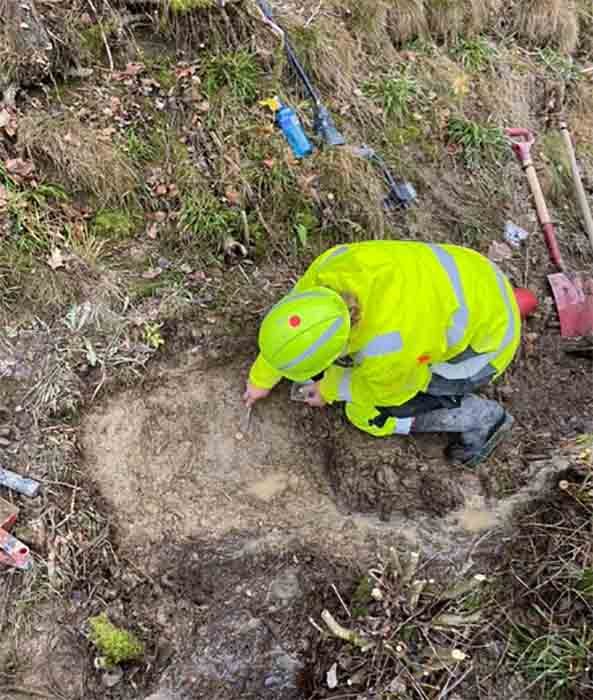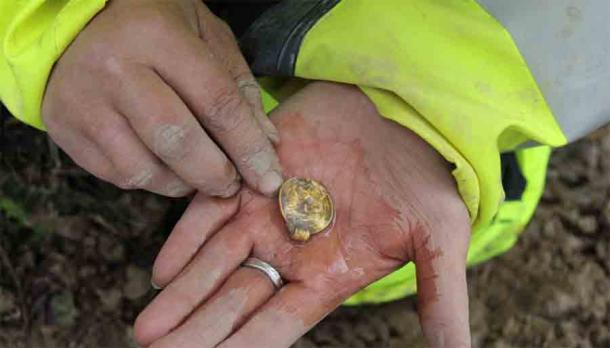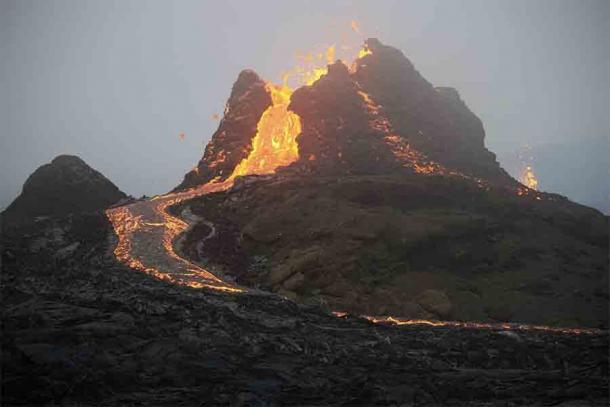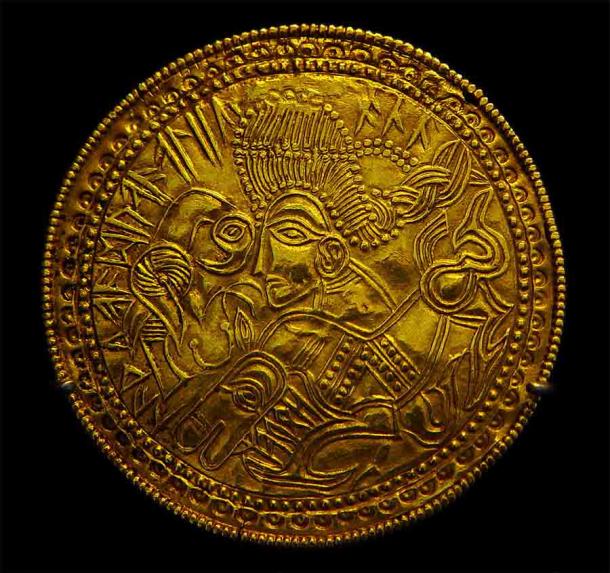In separate discoveries that occurred in 2019 and 2020, searchers found seven ancient gold pendants buried in a field near the Norwegian municipality of Råde in Østfold County. The first four gold pendants were found by a metal detectorist, and the last three by archaeologists from the University of Oslo who performed a follow-up excavation.
These highly-detailed, thinly-cast gold pendants are known as bracteates. They were manufactured in the fifth and sixth centuries AD, by skilled goldsmiths copying a style that was invented by the Romans centuries earlier. While Roman bracteates contained engravings of important political figures, the Norse versions were decorated with stylized or abstract images of Norse gods or animals.

Archaeologist Jessica McGraw unearths the first bracteate find. ( Cultural History Museum )
Norse Elite Gold Pendants Linked To God Odin
The discovery of these unique gold pendants was discussed in a recent blog post by three archaeologists associated with the University of Oslo’s Museum of Cultural History, Jessica Leigh McGraw, Margrete Figenschou Simonsen, and Magne Samdal.
They explain that four of the gold pendants, classified as type C, contain images associated with Odin, the highest-ranking and most well-known of the Norse gods .
“All four C-bracteates from Råde are stamped with an equestrian motif of a horse figure with horns and a human face in profile,” they wrote.
“This may be Odin on his steadfast Sleipnir. It may also be a reproduction of Hermod’s journey to the realm of the dead Hel, to bring Odin’s son Balder back … two of the C-bracteates also depict a crooked-billed bird of prey facing the rider. The symbols represent divine attributes and signs of dignity.”

A closeup of one of the gold bracteates shows a faulty solder seam between the gold bead thread and the central plate where the motif is stamped. (Elin Storbekk / Cultural History Museum )
The bracteates would have been the property of one or more wealthy Scandinavian aristocrats. These influential elites would have buried them as ‘sacrifices’ to Odin and other important Norse deities, in an act of sacrificing something of value to them to win the favor of the gods. In general, the practice was to bury bracteates in hoards, which may have represented the collection of a single individual or a mixture of collectibles contributed by members of an elite group .
This activity was common among Scandinavian elites in the fifth and sixth centuries AD. Over the decades approximately 900 buried bracteates made in Scandinavia have been found, including 160 that were unearthed in Norway.

One of the gold pendants in the location where it was found. (Cultural History Museum )
More Sacrifices As Elites Worry About Their World’s Future
Scandinavian elites began offering their valuable items as sacrifices during a momentous time in history. Their activities coincided with Europe’s Migration Period, which lasted from the fourth through the sixth centuries AD. During this tumultuous time, the besieged Western Roman Empire experienced frequent invasions from Germanic peoples. This ultimately led to the fall of that empire in approximately 476 AD.
During the Migration Period, Roman authority was no longer preserving order in Western Europe. While the invaders were departing from Scandinavia and northern Germany rather than arriving, the general instability of the time may have made elites in Norway feel threatened or uncertain of what the future might hold.
This may have been one reason why so many began to bury hoards of gold items as sacrifices to their gods . They felt they needed protection, and they relied on Odin and his cohorts to help keep them safe from any marauders or pillagers who might target them because of their wealth and power.

Archaeologist Nicolai Eckhoff holds the second bracteate find. ( Cultural History Museum )
But there was another development from this time that was likely far more frightening. Not just to elites, but to everyone else residing in the region.
Between the years 536 and 547, three massive volcanic eruptions in Iceland sent billions of tons of dust and gases high into Earth’s atmosphere. The initial eruption in 536 created a foggy blanket of dense clouds that spread across the globe. The thick cloud cover blocked most of the Sun’s rays, plunging the entire European continent and other parts of the planet into a twilight-style darkness that lasted for 18 months.
During this gray and ominous time, temperatures dropped dramatically, snowstorms occurred constantly and out of season, crops failed everywhere, and waves of starvation swept across Europe.

A volcano crater formed in the volcanic eruption in a valley called Geldingardalir in Iceland in March 2021. The massive Iceland volcano eruptions of 536 and 547 AD created widespread damage and worry in Norse cultures. ( Opus Mutu s / Adobe Stock)
These troubles were soon followed by outbreaks of the plague and other deadly diseases, which preyed on vulnerable people whose immune systems were compromised by food shortages and extreme poverty. Most notorious was the Plague of Justinian , which killed 25 million people in one year after the initial outbreak in Egypt in 541. This plague decimated the population of the Eastern Roman Empire (Byzantine Empire), leading to that great power’s extinction in 543.
In Scandinavian literature, memories of this terrible time have been preserved in mythology, in the form of a prophecy.
Fimbulvetr, which in Old Norse means means “the awful, great winter,” is placed not in the past but in the future. According to Norse traditions, when it arrives Fimbulvetr will be the harshest winter ever experienced. It will last for three years without interruption. It will signal an oncoming apocalyptic event known as Ragnarök, which will cause the destruction of all life on Earth.
The myth of Fimbulvetr was introduced in poems that were first written down a few hundred years after the events of 536-547. While portrayed as prophecy rather than history, the concept of Fimbulvetr clearly has its roots in the real-life catastrophe that Scandinavia experienced in the sixth century AD.
The sudden collapse of the climate that occurred at that time must have been extremely traumatic for everyone who lived through it. It may have seemed like the world really was about to end, and that the gods were angry and taking revenge against the people for all the sins they had committed.
In that context, Scandinavian elites who believed the gods needed to be appeased would have had good reasons to offer their gold treasures as sacrifices. Their actions would have been driven by fear and desperation. Even those who were skeptical of the gods might have been offering sacrifices, believing that divine intervention might be the only way to prevent their society’s extinction.

The Funen bracteate, found in Funen, Denmark. The runic inscription is interpreted as referring to Odin or the “The High One.” (Bloodofox / CC BY-SA 3.0 )
Clinging to Hope in a Time of Darkness
While their analysis is ongoing, Norway’s Museum of Cultural History archaeologists admit they can’t link the burials of the bracteates to a specific event at the present time.
“We don’t know if the gold bracteates from Råde were laid down before or after 536,” they wrote in their blog post. “But it appears as though gold offerings become larger and more numerous during the 500s. In a time of bad years and insecurities, people may have felt a heightened need to try and avoid dangers and seek protection. The Gods needed pleasing, and an increased amount of gold offerings may have taken place.”
The first gold sacrifices may not have been offered in response to any particular occurrence. But it is reasonable to assume the activity would have accelerated after the Sun disappeared, the crops began to fail, and the people began dying in droves. Scandinavian society did survive these horrific calamities, but at the time that survival would have seemed far from assured.
Top image: One of the gold pendants or bracteates recently recovered from a field in Rade, Norway. Source: Margrete F. Simonsen / Cultural History Museum
By Nathan Falde
Related posts:
Views: 0
 RSS Feed
RSS Feed















 May 13th, 2021
May 13th, 2021  Awake Goy
Awake Goy  Posted in
Posted in  Tags:
Tags: 
















